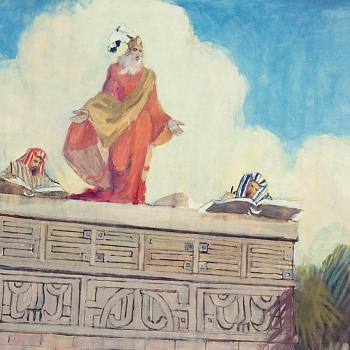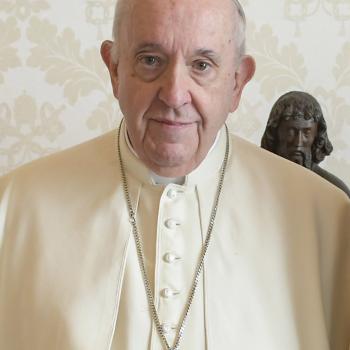I am going to remember this as the year of the upanayanams. Not only is it the year in which my son's upanayanam will be performed, it is the first time I will be attending so many, both in the U.S. and in India. While many sacred sacraments, called samskaras, exist for Hindus this one is the initiation of a young boy into one of the profoundest prayers of the Hindu people: the Gayatri or Savitri mantra. This provides the boy the right to pursue wisdom through the study of the Vedas, and is a compound word: upa means "near," nayanam is "to send." Before the upanayanam, a boy is still a child. Once his upanayanam is complete, the boy or vatu is supposed to stay with a guru, live a life of regulation, pray three times a day, and spend a good part of his time in acquiring knowledge, particularly from the Vedas, the Hindu scriptures. I have been explaining to friends and colleagues that this is my son's "Hindu Bar Mitzvah."
Under Jewish laws, children are not obligated to observe the commandments but they are encouraged to do so as much as possible to learn the obligations they will have as adults. At the age of 13 (12 for girls), boys become obligated to observe the commandments. The words "Bar (or Bat) Mitzvah" actually mean the "son (daughter) of commandment," and the purpose of the Jewish commandments is to keep one's life focused on family, community, and a relationship with God. The bar mitzvah ceremony formally, publicly marks the assumption of that obligation, to form binding contracts, to testify before religious courts, and to marry. The popular bar mitzvah ceremony isn't needed to confer these rights and obligation; it doesn't make you Jewish.
Similarly, having an upanayanam doesn't make one a Hindu. To bring in a Christian analogy, it does, however, mean one is born-again. The vatu (a word describing the boy)receives life—through a physical body—from his parents: this is the first birth. While living with the guru after the upanayanam, the guru imparts knowledge of the scriptures and gives him a life of jnana: this is the second birth.
My mother knew that my son and I wanted to know more about what is involved in the ceremony, so she emailed us a list of steps involved. These include: punyahavachana (preparation of the surroundings, the time), prayaschittam (redemption), and performance of the other jaata karmas (life sacraments, such as naming ceremony) that the boy had from birth to now. She explained that the priest who conducts the ceremony will also make my son step on a stone, to tell him that whatever he will be doing from now on—either in doing his duty justly, in leading a disciplined life, or in fulfilling his wishes or desires rightly—he should be like a rock with a firm mind.
I also did some research and landed at Hinduism Today. I was happy to know that this is not a ceremony to exclude, that young boys of all backgrounds are initiated into study of the Vedas. My son and I discovered that Rama, the avatar of Vishnu, also had an upanayanam, and that there are several other words to denote it: janoi (Gujarati/Hindi), poonal (Tamil), Brahmopadesam (Sanskrit), vodugu (Telugu).
Just as a bar mitzvah is called to read the Torah during the Jewish ceremony, a vatu is being initiated into the sacred Vedic mantra, the Gayatri. Literally, Gayatri means that which protects him who chants it. He must then perform sandhyavandanam thrice daily, an exercise to quiet the mind and render it fit for meditation on the highest truth epitomized by the Gayatri. Since the Gayatri mantra is meditation on the Sun (as god), the priest or guru will take him to show him the sun and other stars.
The initiate is also invested with a sacred thread, a reminder of his connection to that which is holy and sacred. The sacred thread is the yajnopaveeta and is symbolic of the trinities found within the Hindu tradition: Brahma, Vishnu, Siva; Saraswati, Lakshmi, Parvati; Father, Mother, Supreme Spirit; Teacher, Scriptures, Inner-self. There are three cotton threads prepared in a special way and placed across the vatu's neck and chest from left to right (there are variants to this depending on occasion and ritual) and worn daily.
During the ceremony, the vatu also takes a vow of celibacy, and seeks alms and blessings, beginning with his mother and father—this step is the Bhikshakaranam. This is done symbolically today, since parents continue to support their children after the event. This ritual is done to imbibe the virtue of humility—the end result is much like the Jewish event—lots of presents!
But the most important gift of the upanayanam is the Gayatri mantra itself; the translation here is from the late Sathya Sai Baba's site (which also has a fount of information on the Gayatri):
We contemplate the glory of Light illuminating the three worlds: gross, subtle, and causal.
I am that vivifying power, love, radiant illumination, and divine grace of universal intelligence.
We pray for the divine light to illumine our minds.
6/8/2011 4:00:00 AM





